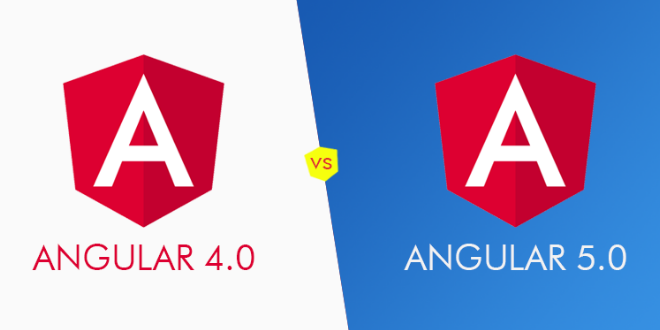
Angular is an all-encompassing JavaScript platform for building mobile and desktop web application. Angular is built and maintained by Google. It is a platform that combines declarative templates, dependency, end to end tooling and integrated best practices to solve development challenges. Angular brings some new features to the JavaScript framework for building desktop, mobile and web applications. Web platforms such as Adsense, Google Adwords, Google Fiber and Winc use Angular to build their user interfaces.
What Is Angular 5?
Angular 5 was released to the world on November 1, 2017, the main focus was to making Angular smaller and faster to use. It came with a whole bunch of new features, service improvement and bug fixes from version 4. Some of the added features include:
- Build optimizer which helps developers in creating smaller bundle that makes the application lighter and faster by removing unnecessary runtime code as well as additional parts.
- Complier Improvements, whereby the diagnostics produced by the compiler have been slightly improved.
- An updated HttpClient
- Addition of support to AppShell. The new support uses the router to render your application.
- Preserve Whitespace- with new Angular 5, one can now choose as to whether or not to restrict newlines, tabs and white spaces coming from your components and your application.
- Angular Universal state transfer
- Reflective injector with Static injector
- Internationalized date and currency
- Speed improvement
What Is Angular 4?
Angular 4 is also a JavaScript framework for building web applications and apps in JavaScript, html, and TypeScript, which is a superset of JavaScript. Angular 4 was released on March 6, 2017 and was as a result of complete rethinking of Angular 1. In this version, some basic concepts such as modules, controllers, scopes and directives have be removed or replaced. Other features of Angular 4 include:
- Support for email validator
- Support for if/else statement
- Animation moved out to a separated package @angular/animations
- Reduced the size of the generated bundled code up to 60%
The Difference
- Angular 4 was released in March 2017, with a major release jump from version 2 whereas Angular 5 was released in November 2017 with lots of exciting features.
- Angular 4 has @angular/HTTP package with a module referred to as HttpClient whereas Angular 5 has @angular/component/HTTP package and introduced a new module referred to as HttpClientModule.
- Angular 4 does not support multiple naming schemes while Angular 5 support multiple directives and components.
- Angular 4 has a conventional approach for tracking lifecycle events, on the other hand, Angular 5 has new router life cycle events added to it which enables the developer with a more vivid tracking ability.
- Angular 4 has support for the TypeScript 2.2 and 2.1 versions whereas Angular 5 has support only TypeScript 2.5.
- Angular 4 does not possess build optimizer like feature while Angular 5 has build optimizer which actually assists in removing the unnecessary code from the application.
- Angular 4 does not give the choice to restrict the unnecessary whitespaces, tabs and newlines. On the other hand, Angular 5 give the choice to restrict tabs, whitespaces and newlines.
- Angular 5 has API for Angular Universal state transfer, within which the state of the application between client and server can be shared. On the contrary, Angular 4 does not have this API between client-server interactions.
- Angular 4 does not have complier enhancement installed in it whereas Angular 5 has significant improvement with complier, support of incremental feature of application.
- Angular 4 uses naming functions instead of lambda while Angular 5 has lambda expression, which gives a more compact code.
ALSO READ: Difference Between Angular 2 and Angular 4
Difference Between Angular 5 And Angular 4 In Tabular Form
| BASIS OF COMPARISON | ANGULAR 4 | ANGULAR 5 |
| Year Of Release | Angular 4 was released in March 2017, with a major release jump from version 2. | Angular 5 was released in November 2017 with lots of exciting features. |
| Module | Angular 4 has @angular/HTTP package with a module referred to as HttpClient. | Angular 5 has @angular/component/HTTP package and introduced a new module referred to as HttpClientModule. |
| Advantage/Disadvantage | Angular 4 does not support multiple naming schemes. | Angular 5 support multiple directives and components. |
| Approach | Angular 4 has a conventional approach for tracking lifecycle events. | Angular 5 has new router life cycle events added to it which enables the developer with a more vivid tracking ability. |
| TypeScript | Angular 4 has support for the TypeScript 2.2 and 2.1 versions. | Angular 5 support multiple directives and components. |
| Build Optimizer | Angular 4 does not possess build optimizer like feature. | Angular 5 has build optimizer which actually assists in removing the unnecessary code from the application. |
| Restriction | Angular 4 does not give the choice to restrict the unnecessary whitespaces, tabs and newlines. | Angular 5 give the choice to restrict tabs, whitespaces and newlines. |
| Universal state transfer API | Angular 4 does not have Universal state transfer API between client-server interactions. | Angular 5 has API for Angular Universal state transfer, within which the state of the application between client and server can be shared. |
| Complier | Angular 4 does not have complier enhancement installed in it. | Angular 5 has significant improvement with complier, support of incremental feature of application. |
| Lambda Expression | Angular 4 uses naming functions instead of lambda. | Angular 5 has lambda expression, which gives a more compact code. |
Also Read: Difference Between Open Database Connectivity And Java Database Community